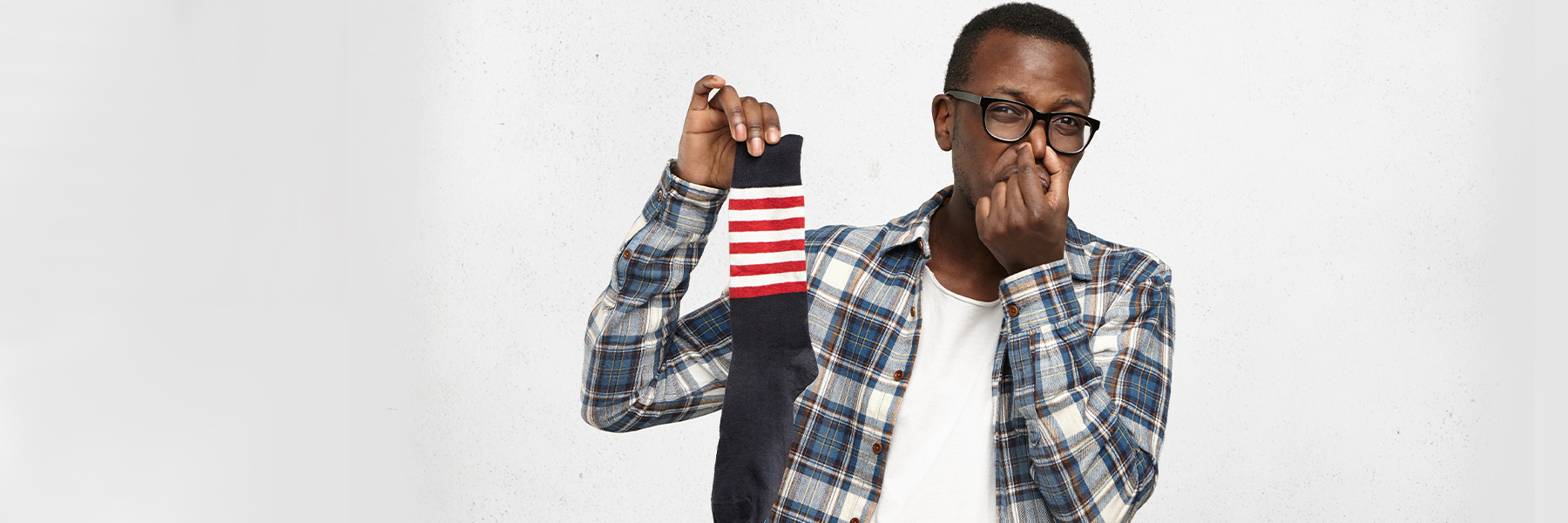Among the many changes that are happening to your body as you are growing and developing, one area you might not think of right away are your feet!
Feet are also affected during puberty and onward as they continue to grow, sweat, and sometimes smell! Read on to learn more about the reasons behind these changes and what to do about them.
Self-Foot Exam
First, to assess your feet, the best thing to do is take a look! Doing a routine foot exam is important in foot health. Things to notice include:
-
Cuts/Scratches
Minor injuries or breaks in the skin may be able to be treated with over-the-counter topical cream, however, you need to first keep them clean and cover wounds with a Band-Aid. Consult a medical professional if you start to notice any signs of infection.
-
Blisters
Blisters are raised areas on the skin that have a bubble-like appearance. They are usually filled with clear fluid and are caused by friction or rubbing. If you notice a blister, it is usually after a day of lots of physical activity or after wearing a pair of shoes that don’t fit quite right. If you notice that you keep getting blisters in the same place, consider changing the type of shoes you wear while doing certain activities. Another option is to wear thicker socks that have more cushion and protect from rubbing. While you have a blister, try not to pop it and apply a Band-Aid. Eventually, your body will re-absorb the fluid in the blister and it will go away.
-
Calluses
Calluses are common on the bottom of the foot and indicate an area of pressure, especially in athletes and highly active people. Calluses are thickened or tough areas on the bottom or sides of the feet. Think of them as your skin “toughening up” in areas that often experience a lot of pressure. Sometimes calluses are skin colored, or they can appear white-ish or like dry skin. To avoid further thickening, you can either buy cushion inserts to put in your shoes or consider wearing a different type of shoes that have more padding and support. Additionally, apply moisturizer and/or lightly exfoliate the area of the callus to soften the skin.
-
Warts
Plantar warts are more common in childhood but can still occur throughout puberty and into adulthood. A plantar wart can look like a circular area of raised skin that feels rough to the touch and often has tiny black specks in the middle. There are over-the-counter and home remedies for plantar warts. However, if the plantar warts are painful, bleeding, or not resolving, it is time to see a medical professional. Prevent these warts by keeping your feet clean and dry and avoid barefoot walking in public places, especially swimming pools and locker rooms, as these warts thrive in moist and warm environments.
-
Hair
Hair growth on the top of the foot and on toes is normal and will become more noticeable as your body grows and develops into adulthood.
-
Shape
The shape of your feet should be about the same on both sides. If you notice any new lumps or bumps, have your medical professional check it.
-
Moisture
Both excessively dry skin as well as damp skin can cause their own problems long-term. If your skin is very dry, deep cracks can develop in the skin that bleed and can be painful. If your skin is too moist, athlete’s foot can occur, which is a fungal infection. To combat dry skin, apply moisturizer regularly to keep skin hydrated. To avoid excessive moisture, change your socks more frequently (especially after sweating) and wear athletic socks that are designed to be more moisture-wicking.
-
Nails
Ingrown nails or discoloration is a possible sign of an injury or stubbed toe. If it is causing discomfort and not resolving, visit your doctor.
-
Odor
Smelly feet can be as simple as needing a good wash or could be a sign of athlete’s foot or an infection. To avoid smelly feet, start by always keeping your feet clean and dry. Wear fresh socks every day and change your socks after sweating. Consider buying athletic socks that are made of materials that wick moisture away from the feet. Finally, give your feet some air! Let them have a few hours of open air every day without socks.
Foot Hygiene
During puberty, the increased amount of hormones in your body causes sweat glands to be more active. In fact, feet can produce up to one pint of sweat in just one day! Therefore, remember to wash your feet daily. Even after your sweat has dried, a thin layer of bacteria and enzymes remain on the skin, although you can’t see them!
Aside from daily bathing, another tip to keeping feet clean and healthy is: wear a fresh pair of socks every day. Yes, even if those socks from yesterday don’t look dirty, they have absorbed all of that sweat and bacteria from yesterday.
Another helpful hint is to avoid wearing the same exact pair of shoes every day. Having more than one pair of shoes, including sneakers, gives the other pair a chance to fully dry out before you wear them again. If your feet are extra sweaty or you do not have another pair of shoes, you can put a foot powder in them overnight to absorb the moisture.
Toenail Care
In addition to being clean, nails must also be trimmed and kept at an appropriate length. Longer toenails get caught on socks or blankets which can be painful or cause injury. For this reason, trim your nails to a shorter length. In general, a healthy rule is to keep 1-2 mm of white at the end of your nails (about the height of a flat penny).
When trimming your nails, use the correct tools. There is a difference between fingernail and toenail clippers: toenail clippers are larger and are easier to cut straight across with. Also remember to use clean clippers. If you share the same clippers with others, you do not want any bacteria or fungus transferring to your feet! Use alcohol or a disinfectant to wipe the clippers down before and after using.
Avoid cutting diagonal or curved on the sides of the nail to avoid ingrown nails. If the corners are sharp after you have clipped them, use a nail file to gently file the corners until they are no longer sharp. If you do not have a nail clipper, you can also use a nail file on the edge of the entire nail to gradually shorten the nail the rest of the way.
Growing Feet
When you think about growing pains, most people commonly think of the legs or arms, but growing pains can happen in the feet too! Your feet grow throughout puberty and do not officially stop growing until age 18-20. As such, remember that this means your shoe size may change as well!
Top 3 Teen Foot Conditions & How to Help
Athlete’s foot
Athlete’s foot is named as such because it is quite common in athletes. Athletes tend to sweat more and wear the same pair of shoes for their sport, so they are more susceptible to increased moisture. If there is too much moisture for too long, a fungus can occur called tinea pedis, commonly known as “athlete’s foot.” The most common symptoms of athlete’s foot include foul odor, itching, scaly or flaky skin (especially between the toes), or redness. In order to treat athlete’s foot, you need to consult a doctor.
Bunions
If you look down at your feet and see a bump on the side by your big toe, you probably have something called a bunion. Bunions are common at all ages, are not harmful or dangerous, and are caused by genetics. The only time bunions are concerning is when they cause pain. If your bunion is rubbing in your shoe or is red at the end of the day, it is likely because your shoes are too narrow. Buy wider shoes or shoes with a flexible top cover (like athletic shoes) to allow more room and prevent rubbing in the shoe. If the pain goes beyond fixing your shoes, consider seeing a podiatrist who specializes in treating this problem.
Ingrown toenails
Ingrown toenails occur when the corner of your nail (mostly on the big toes) is growing into the skin along the side of the nail, causing redness and pain, especially when bumped or hit. These can sometimes be due to not cutting the nails straight across, shoes that are too tight, or genetics. There are minor surgical procedures that can be done in a medical professional’s office to remove the ingrowing portion and prevent it from growing back.




